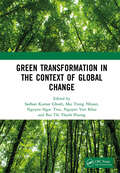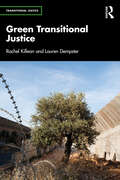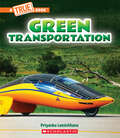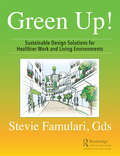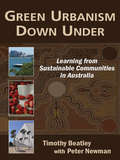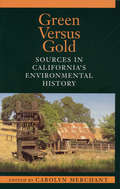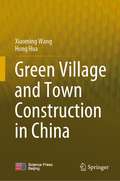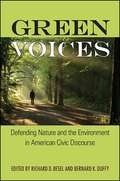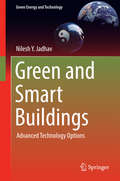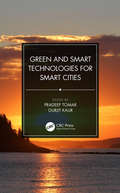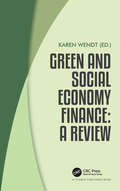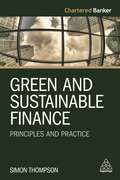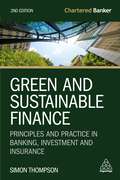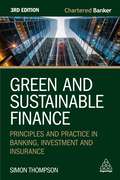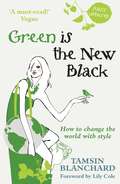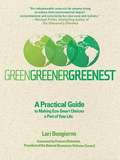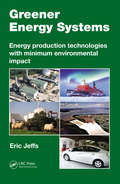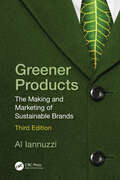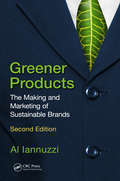- Table View
- List View
Green Transformation in the Context of Global Change: Proceedings of the International Conference on Green Transformation in the Context of Global Change (GREEN 2024), Hanoi, Vietnam, October 24th–25th, 2024
by Sadhan Kumar Ghosh Mai Trong Nhuan Nguyen Ngoc Truc Nguyen Viet Khoi Huong, Bui Thi ThanhThis book captures the proceedings of the International Conference on Green Transformation in the Context of Global Change (GREEN 2024), organized by the School of Interdisciplinary Sciences and Arts, Vietnam National University, Hanoi. Each of the eight sections in this volume offer an interdisciplinary forum to exchange valuable information and knowledge on green transformation.It emphasizes the need for new, flexible and creative solutions to tackle the enormous challenges of global change such as geopolitical conflicts, climate change, environmental degradation, biodiversity loss, clean water and food shortage, economic instability, poverty, and social inequality.It touches upon several crucial topics, including: Green transformation in the digital transformation context Emission reduction and energy transition Agro-ecology and sustainable food systems It will be a valuable read for researchers and practitioners of waste management, green manufacturing, sustainable development and climate change.
Green Transition and the Quality of Work: Implications, Linkages and Perspectives
by Tindara Addabbo Edoardo Ales Ylenia Curzi Tommaso Fabbri Iacopo SenatoriIn 2019 the European Green Deal was launched by the European Commission with the aim of making the European Union climate neutral by 2050. Five years on from that, this contributed volume analyses the extensive impact that it has produced on labour relations, from a Labour Law and HRM perspective, and put forward some new ideas on the (just) ‘green transition’ and quality of work. In order to move the discussion forward and to promote a multidisciplinary debate on the key issues related to the implications, linkages and perspectives of the Green Transition on the quality of work, this book provides contributions from the international scholarly community on some crucial topics like regulatory strategies and players of environmental and employment policies as well as the role of the firm in environmental policies, their promotion and its accountability. It will be of great interest to scholars and students of sustainability, HRM, labour, innovation and public administration.
Green Transitional Justice (Transitional Justice)
by Rachel Killean Lauren DempsterThis book rethinks the boundaries of transitional justice, urging scholars and practitioners to confront the often-overlooked nexus between mass violence and ecological harm.Through an in-depth analysis of the field’s limitations – such as its anthropocentric legalism, neocolonial practices, and alignment with neoliberalism – the book critiques the historical marginalisation of Nature in transitional justice discourse and practice. It argues that ignoring environmental harm not only undermines the possibility of holistic justice but also perpetuates structural violence and inequality. In response, the book sketches a ‘greener’ transitional justice, integrating principles from environmental justice, Indigenous knowledge systems, and ecocentric perspectives. It explores the possibilities of recognising Nature as a victim of mass violence, adapting existing mechanisms to incorporate environmental harm, and fostering transformative approaches premised on the interdependence of human and ecological well-being.This book is written for students, researchers, and practitioners of transitional justice and fields related to conflict transformation, peacebuilding, environmental protection, and development.
Green Transportation (A True Book (Relaunch))
by Priyanka LamichhaneEnvision a brighter future with this STEM-based subset of True Books.Electric cars. Solar-powered planes. Poop-fueled trucks. Each of these technological advances in transportation is bringing us ever closer to a green future, and more are being developed all the time. Considering how many vehicles are on our roads = and in the water and air = sustainable transportation might be the most important innovation we can make to ensure our planet's future. Learn how in Green Transportation.ABOUT THE SERIES:What would a green future look like? Will trains and airplanes be powered by the sun? Will we have homes that have zero impact on the environment? The most pressing challenge facing us today is how to ensure a healthy Earth for ourselves and future generations. This STEM-based set of A True Books introduces students to the engineering innovations that can help us reach those goals. Interesting information is presented in a fun, friendly way = and in the simplest terms possible = and will inspire kids to start envisioning and enacting a more sustainable future.
Green Up!: Sustainable Design Solutions for Healthier Work and Living Environments
by Stevie FamulariThere are unique greening solutions and practices that help create a lifestyle shift, improving the health of living and working spaces for its occupants from a personal, business, environmental, and profitable perspective. Short-term and long-term considerations are important elements when moving forward towards healthy practices in lifestyles, choices, and site designs. This book addresses a myriad of greening practices that can be applied to structures in our urban, suburban, and rural cultures. From the loft to the neighborhood, the office spaces to the public spaces, and the schools to the communities, this book outlines how business owners and residents can integrate scale appropriate green solutions into their lifestyles. Green Up!: Sustainable Design Solutions for Healthier Work and Living Environments includes detailed illustrations and photographs to help you understand design opportunities for your space. Stevie Famulari provides unique insights and inspires business owners, residents, and planners to develop their own green understanding and design solutions. Illustrations and photographs of applied greening are included throughout the book to help inspire your own goals and design, and then transform them to reality. The author breaks down the misconceptions of the complexity of sustainability and green practices. Greening is a lifestyle change, and this step-by-step instruction guide lets you know how easy it is to transition to the green side!
Green Urbanism Down Under: Learning from Sustainable Communities in Australia
by Timothy Beatley Peter NewmanIn this immensely practical book, Timothy Beatley sets out to answer a simple question: what can Americans learn from Australians about "greening" city life? Green Urbanism Down Under reports on the current state of "sustainability practice" in Australia and the many lessons that U.S. residents can learn from the best Australian programs and initiatives. Australia is similar to the United States in many ways, especially in its "energy footprint." For example, Australia's per capita greenhouse gas emissions are second only to those of the United States. A similar percentage of its residents live in cities (85 percent in Australia vs. 80 percent in the United States). And it suffers from parallel problems of air and water pollution, a national dependence on automobiles, and high fossil fuel consumption. Still, after traveling throughout Australia, Beatley finds that there are myriad creative responses to these problems--and that they offer instructive examples for the United States. Green Urbanism Down Under is a very readable collection of solutions. Although many of these innovative solutions are little-known outside Australia, they all present practical possibilities for U.S. cities. Beatley describes "green transport" projects, "city farms," renewable energy plans, green living programs, and much more. He considers a host of public policy initiatives and scrutinizes regional and state planning efforts for answers. In closing, he shares his impressions about how Australian results might be applied to U.S. problems. This is a unique book: hopeful, constructive, and filled with ideas that have been proven to work. It is a "must read" for anyone who cares about the future of American cities.
Green Urbanism: Learning From European Cities
by Timothy BeatleyAs the need to confront unplanned growth increases, planners and policymakers scramble for practical tools and examples of successful and workable approaches. Growth management initiatives are underway in the US, but many American "success stories" provide only one piece of the puzzle. To find examples of a holistic approach to dealing with sprawl, one must turn to models outside of the United States.In Green Urbanism, Timothy Beatley explains what planners and local officials in the United States can learn from the sustainable city movement in Europe. The book explores the progress and policies of twenty-five of the most innovative cities in eleven European countries. Chapters examine:*the sustainable cities movement in Europe*examples of different housing and living options*policies for promoting transit and bicycle use and minimizing the role of the automobile*creative ways of incorporating greenness into cities*ways of readjusting "urban metabolism" so that waste flows become circular*programs to promote more sustainable forms of economic development*sustainable design measures and features*renewable energy initiatives and local efforts to promote solar energy*ways of greening local government decisions including ecological budgeting, green accounting, and other city management tools.Throughout, Beatley focuses on the key lessons from these cities -- including Vienna, Helsinki, Copenhagen, Stockholm, Zurich, Amsterdam, London, and Berlin -- and what their experience can teach us about effectively promoting sustainable development in the United States. Green Urbanism is the first full-length book to describe urban sustainability in European cities, and provides concrete examples and detailed discussions of innovative and practical sustainable planning ideas.
Green Versus Gold: Sources In California's Environmental History
by Carolyn MerchantWhile the state of California remains one of the most striking and varied landscapes in the world, it has experienced monumental changes since European settlers first set foot there. The past two centuries have witnessed an ongoing struggle between environment and economy, nature and humanity that has left an indelible mark on the region.Green Versus Gold provides a compelling look at California's environmental history from its Native American past to conflicts and movements of recent decades. Acclaimed environmental historian Carolyn Merchant has brought together a vast storehouse of primary sources and interpretive essays to create a comprehensive picture of the history of ecological and human interactions in one of the nation's most diverse and resource-rich states.For each chapter, Merchant has selected original documents that give readers an eyewitness account of specific environments and periods, along with essays from leading historians, geographers, scientists, and other experts that provide context and analysis for the documents. In addition, she presents a list of further readings of both primary and secondary sources. Among other topics, chapters examine:California's natural environment and Native American lands the Spanish and Russian frontiers environmental impacts of the gold rush the transformation of forests and rangelands agriculture and irrigation cities and urban issues the rise of environmental science and contemporary environmental movement.Merchant's informed and well-chosen selections present a unique view of decades of environmental change and controversy. Historians, educators, environmentalists, writers, students, scientists, policy makers, and others will find the book an enlightening and important contribution to the debate over our nation's environmental history.
Green Village and Town Construction in China
by Xiaoming Wang Hong HuaBy means of multidisciplinary research on urban and rural planning, construction engineering, environmental engineering and engineering sociology, this book conducts pioneering research on the construction theory, construction methods, evaluation technology and application of demonstration projects in China’s green villages and towns. The book is divided into three parts and eleven chapters. Part I is about the theory and development of green village and town construction, including the theory and innovation, the evolution and development, the patterns and mechanisms, and the community of green village and town construction. Part II is about the planning and construction methods of green villages and towns, including the plan compilation, the environmental infrastructure construction, and the construction and renovation of green buildings in villages and towns. Part III is about the evaluation of the planning and construction of green villages and towns, including the evaluation of plans, the evaluation of environmental infrastructure construction, the evaluation of green building construction, and the comprehensive evaluation of the planning and construction of green villages and towns. Today, 564 million farmers live in 28,500 towns and 2.452 million villages in China. In 2018 alone, 820 million m2 of new houses were built in rural areas. This proves that China’s green village and town construction has great significance and can provide enlightenment to developing countries and even to the world. The book describes new theories, new perspectives and new methods of green village and town sustainable construction in China for overseas experts and readers.
Green Voices: Defending Nature and the Environment in American Civic Discourse (SUNY Press Open Access)
by Richard D. Besel; Bernard K. DuffyThe written works of nature's leading advocates—from Charles Sumner and John Muir to Rachel Carson and President Jimmy Carter, to name a few—have been the subject of many texts, but their speeches remain relatively unknown or unexamined. Green Voices aims to redress this situation. After all, when it comes to the leaders, heroes, and activists of the environmental movement, their speeches formed part of the fertile earth from which uniquely American environmental expectations, assumptions, and norms germinated and grew. Despite having in common a definitively rhetorical focus, the contributions in this book reflect a variety of methods and approaches. Some concentrate on a single speaker and a single speech. Others look at several speeches. Some are historical in orientation, while others are more theoretical. In other words, this collection examines the broad sweep of US environmental history from the perspective of our most famous and influential environmental figures.This book is freely available in an open access edition thanks to Knowledge Unlatched—an initiative that provides libraries and institutions with a centralized platform to support OA collections and from leading publishing houses and OA initiatives. Learn more at the Knowledge Unlatched website at: https://www.knowledgeunlatched.org/, and access the book online at the SUNY Open Access Repository at http://hdl.handle.net/20.500.12648/7126.
Green Wars: Conservation and Decolonization in the Maya Forest
by Megan YbarraGlobal conservation efforts are celebrated for saving Guatemala’s Maya Forest. This book reveals that the process of protecting lands has been one of racialized dispossession for the Indigenous peoples who live there. Through careful ethnography and archival research, Megan Ybarra shows how conservation efforts have turned Q’eqchi’ Mayas into immigrants on their own land, and how this is part of a larger national effort to make Indigenous peoples into neoliberal citizens. Even as Q’eqchi’s participate in conservation, Green Wars amplifies their call for material decolonization by recognizing the relationship between Indigenous peoples and the land itself.
Green Washed
by Kendra Pierre-LouisThe message that our environment is in peril has filtered from environmental groups to theAmerican consciousness to our shopping carts. Every day, millions of Americans dutifully replace conventional produce with organic, swap Mr. Clean for Seventh Generation, and replace their bottled water with water bottles. Many of us have come to believe that the path to environmental sustainability is paved by shopping green. Although this green consumer movement certainly has many Americans consuming differently, it raises an important and rarely asked question--"is this consumption really any better for the planet?" By examining the major economic sectors of our society, including infrastructure (green housing), consumer goods (green clothing and jewelry), food (the rise of organic), and energy (including solar power and the popularity of the hybrid car), Green Washed: Why We Can't Buy Our Way to a Green Planet explains that, though greener alternatives are important, we cannot simply buy our way to sustainability. Rather, if it is the volume of our consumption that matters, can we as a society dependent on constantly consuming ever be content with buying less? A new and unique take on green consumption, Green Washed shows how buying better is only the first step toward true sustainability. Kendra Pierre-Louis is the sustainable development editor for Justmeans.com. She holds a master's degree in sustainable development from the SIT Graduate Institute in Vermont. She has created outreach material for the United Nations Environment Programme's Convention on Biological Diversity and worked as a researcher for Terrapin Bright Green, an environmental consulting and strategic planning firm.
Green and Blue Economy Frameworks for Halal Industry Sustainability
by Lukman Raimi Monsuru Adekunle Salisu Nurudeen Babatunde Bamiro Isa Olalekan ElegbedeThis book serves as a valuable resource for economic policymakers, economic analysts, halal trainers, halal stakeholders, agribusiness advocates, and halal industry consultants in the rapidly changing emerging green and blue economy. The book explores the themes of green and blue economies for halal industry sustainability and business entrepreneurship as well as production and consumption, ethics and impact investments in halal, green and blue entrepreneurship, and principles governing the innovation of production framework through integration of green and blue economy. The green and blue economy frameworks can be applied to the Halal industry to enhance its sustainability and promote environmental and social responsibility. This book presents the emerging blue and green economy to halal entrepreneurs as a complementary alternative model for enterprise development, wealth creation, employment creation, responsible production, and sustainable consumption and a catalyst for attaining sustainable development goals.
Green and Smart Buildings
by Nilesh Y. JadhavThis book highlights the various technologies that are currently available or are now being developed for the green and smart buildings of the future. It examines why green building performance is important, and how it can be measured and rated using appropriate benchmarking systems. Lastly, the book provides an overview of the state-of-the-art in green building technologies and the trend towards zero energy or net positive energy buildings in the future.
Green and Smart Technologies for Smart Cities
by Pradeep Tomar Gurjit KaurThe book starts with an overview of the role of cities in climate change and environmental pollution worldwide, followed by the concept description of smart cities and their expected features, focusing on green technology innovation. This book explores the energy management strategies required to minimize the need for huge investments in high-capacity transmission lines from distant power plants. A new range of renewable energy technologies modified for installation in cities like small wind turbines, micro-CHP and heat pumps are described. The overall objective of this book is to explore all the green and smart technologies for designing green smart cities.
Green and Social Economy Finance: A Review
by Karen WendtGreen and Social Economy Finance is a compilation of chapters by experts, linking research and practice. This anthology provides a new thinking on social economy green finance, showing emerging themes and trends. It spans from stock markets, green finance, innovations, digitalization to social finance, governance and theories of change. It concentrates on impact, opportunity recognition and development of financial products designed to finance the green and social economy. Without the attraction of capital, social entrepreneurship, and innovations, green finance can face difficulty in addressing business solutions. Green and social economy is a nascent field. The authors address the conceptualization of green and social solutions and identify new trends in the finance industry products and approaches. The book demonstrates that aligning finance and investment with the Paris Agreement, sustainable development goals and needs and interests of society are feasible.
Green and Sustainable Finance: Principles and Practice (Chartered Banker Series #6)
by Simon ThompsonMore than 120 countries have committed to net zero targets by 2050, requiring systemic economic transitions on an unprecedented scale and with the finance sector playing a leading role. Green finance will power the transition, ensuring capital flows to the firms, investments, projects and technologies looking to create a sustainable, low-carbon world. To achieve net zero, every professional financial decision must take climate change and broader sustainability factors into account. Green and Sustainable Finance provides a comprehensive guide to the application of common green and sustainable principles and practices in banking, investment and insurance to help finance professionals embed these in their daily activities and decision-making. Focusing on the necessity of mainstreaming green and sustainable finance globally, this book includes a clear explanation of the science underpinning climate change. Green and Sustainable Finance covers a wide range of green finance products and services in retail, commercial and corporate banking, insurance, investment and fintech. It provides an overview of emerging regulation and international market frameworks and standards, particularly in relation to climate and environmental risk. Consideration is also given to the ethical dimensions of green and sustainable finance, including how professionals can promote market integrity and take active steps to avoid greenwashing. Endorsed by the Chartered Banker Institute as the core text for the benchmark Certificate in Green and Sustainable Finance, this book is essential reading for finance professionals and students, and individuals working to embed sustainability in business, policy and regulation.
Green and Sustainable Finance: Principles and Practice in Banking, Investment and Insurance (Chartered Banker Series #7)
by Simon ThompsonTo achieve society's goals, as set out in the UN Sustainable Development Goals and the Paris Agreement, the finance sector has a crucial role to play in driving sustainable business and the transition to a net zero economy.To achieve this change, it is vital for the finance sector to allocate capital to the firms, investments and activities looking to create a more sustainable world. Green and Sustainable Finance offers a comprehensive guide to green and sustainable principles and practice in banking, investment and insurance to help finance professionals manage sustainability risks and support their clients and customers in transition. Given the need for urgent, rapid and sustained change, it is essential that all finance professionals understand and apply these principles so that every professional financial decision takes account of sustainability.Written by the CEO of the Chartered Banker Institute this fully updated second edition includes the most recent assessments of climate science from the IPCC, extended coverage of sustainability reporting and carbon accounting, and regulatory and market developments in sustainability risk management. It also features material on the rapid growth of sustainable lending and investment and the latest finance sector alliances and initiatives. Endorsed by the Chartered Banker Institute as the core text for the global benchmark Certificate in Green and Sustainable Finance, this book is essential reading for finance professionals, university students and individuals working to embed sustainability in business, finance, policy and regulation.
Green and Sustainable Finance: Principles and Practice in Banking, Investment and Insurance (Chartered Banker Series)
by Simon ThompsonThe finance sector has a crucial role to play in delivering a sustainable future for the planet. To address the Triple Planetary Crisis of climate change, pollution and biodiversity loss, it is vital that the finance sector rapidly accelerates the mobilization of capital to support a successful and just transition to net zero. This requires enhancing both the capabilities of financial institutions and developing the knowledge and skills of finance professionals so that every financial decision takes account of climate change and sustainability.Green and Sustainable Finance is a comprehensive guide to the principles and practice required to manage sustainability risks, engage and support clients, and take advantage of the opportunities presented by the transition of sectors and firms to new, low carbon and nature positive models.This fully updated third edition incorporates a wider perspective with nature-based impacts, risks, dependencies and opportunities considered alongside climate change. It introduces the work of the new International Sustainability Standards Board (ISSB) and the Taskforce on Nature-related Financial Disclosures (TNFD) along with extensive coverage of wider regulatory and market developments. There is also additional content on adaptation finance, transition finance and transition planning. Endorsed by the Chartered Banker Institute as the core text for the global benchmark Certificate in Green and Sustainable Finance, this book is essential reading for finance professionals, university students and individuals working to embed sustainability in business, finance, policy and regulation.
Green is the New Black: How to Save the World in Style
by Tamsin BlanchardFor girls who care about global warming, and next season's hot looks, Green is the New Black is a must-have accessory. Does our shopping addiction contribute to climate change? What's so special about organic cotton? Who are the real fashion victims behind the £3 jeans? From the truth about fast fashion to the best biodegradable shoes, from guilt-free spending sprees to the joys of swishing parties, Tamsin Blanchard is your guide to all things fairtrade and fabulous. She explains the principles of ethical fashion, from why it matters to how to do it. Offers tips for the aspiring green goddess: including how to knit your own scarf, seduction in eco-couture, the best places to shop for vintage sunglasses, and ethical bling. And includes fun facts and essential directories on every aspect of sustainable stylish living. With fashion secrets from celebrity friends, Green is the New Black is the chicest, greenest survival manual around. If you want to change the world, and your wardrobe, don't go shopping without it.
Green's Functions and Linear Differential Equations: Theory, Applications, and Computation (Chapman & Hall/CRC Applied Mathematics & Nonlinear Science)
by Prem K. KytheGreen's Functions and Linear Differential Equations: Theory, Applications, and Computation presents a variety of methods to solve linear ordinary differential equations (ODEs) and partial differential equations (PDEs). The text provides a sufficient theoretical basis to understand Green's function method, which is used to solve initial and boundary
Green, Greener, Greenest
by Lori Bongiorno Frances BeineckeHow green can you be? Green: Drive the speed limit Greener: Drive a fuel-efficient car Greenest: Bike or walk The perfect guide to help readers decide how to best spend their time and money to protect the environment, Green, Greener, Greenest offers flexible tips for everyday living, all categorized as "green," "greener," and "greenest." Cutting through the labeling and the hype, it helps readers choose the advice that fits their schedule, their budget, and their interests, with the understanding that there's never one "right way" to make a difference. This indispensable resource will grow with readers-whether a novice in green living or a veteran environmentalist-as their interests and needs change over time.
Greener Energy Systems: Energy Production Technologies with Minimum Environmental Impact
by Eric JeffsRecent years have seen acceleration in the development of cleaner energy systems. In Europe and North America, many old coal-fired power plants will be shut down in the next few years and will likely be replaced by combined cycle plants with higher-efficiency gas turbines that can start up and load quickly. With the revival of nuclear energy, designers are creating smaller nuclear reactors of a simpler integrated design that could expand the application of clean, emission-free energy to industry. And a number of manufacturers now offer hybrid cars with an electric motor and a gasoline engine to charge the batteries on the move. This would seem to be the way forward in reducing transport emissions, until countries develop stronger electricity supply systems to cope with millions of electric cars being charged daily. Greener Energy Systems: Energy Production Technologies with Minimum Environmental Impact tackles the question of how to generate enough electricity, efficiently and with minimum environmental impact, to meet future energy needs across the world. Supplemented with extensive figures and color photographs, this book: Traces the development of electricity supply Explains energy production risks and how major accidents have influenced development Discusses the combined cycle, the preferred system for power capacity expansion in much of the world Looks at combined heat and power Addresses whether coal can continue to be a fuel for power generation Examines nuclear power generation Asks why shipping has not followed some of the world's navies into nuclear propulsion Considers how to electrify more transport systems Reviews the current state of renewable systems, particularly hydro and solar The book defines the key elements of greener energy systems, noting that they must be highly efficient, with rapid start up and loading; produce minimum emissions; and use simpler technology. The author has more than forty years of experience as an international journalist reporting on power-generation technologies and energy policies around the world. He concludes that there is no place for coal and that combined cycle, hydro, solar, and biomass must complement nuclear energy, which must serve more applications than just generating electricity.
Greener Products: The Making and Marketing of Sustainable Brands
by Al IannuzziSustainability and its competitive advantage are the goals of every company and any brand that wants to stay successful in the marketplace. Customers also gravitate to brands that manage sustainability issues well. Greener Products: The Making and Marketing of Sustainable Brands written by a renowned sustainability expert, continues to address the latest developments in the extremely fast-moving field of sustainability. The third edition is thoroughly updated, introduces new case studies, and includes a new chapter on green marketing. With over 40 case studies, it explores the best practices of leading global companies and helps readers learn what it is that makes them successful.New in the Third Edition: Presents, in a practical way, the best practices of sustainable brands in a global economy. Addresses the most current sustainability topics like circular economy, plastics in the environment, biodiversity, climate change, green chemistry, etc. Includes current marketing information on consumer trends to purchase greener products. Incorporates the latest pressures on companies to address sustainability, retailer programs, business-to-business expectations, ESG raters, rankers, and stock funds. Covers best practices of companies from various industries on how to make and market greener products. Provides current tools for making products more sustainable and methods on how to market sustainable improvements. Includes lecture slides available upon request for use in the classroom. This book serves senior undergraduate and graduate students in programs focused on sustainability, as well as academics and corporate sustainability leaders. The previous versions have been used to teach courses on sustainability, product improvement, introduction to sustainability, green marketing and sustainability, and sustainability policy. Any university that teaches a course on sustainability and any company or individual interested in making and marketing more sustainable products would benefit from the new edition of this book.
Greener Products: The Making and Marketing of Sustainable Brands, Second Edition
by Al IannuzziWritten by a renowned sustainability expert, Greener Products: The Making and Marketing of Sustainable Brands, Second Edition makes the case for why the people and the planet need products to be made in a different, more sustainable way. The growth of the global middle class, with an additional 3 billion people expected to enter the consumer market by 2030, is putting an unprecedented demand on resources and straining the global supply of raw materials, fossil fuels, food and water. This book provides insights on how to raise the bar on product development and investigates the best practices for making and marketing sustainable brands. Over 40 case studies are analyzed in this book and summarized for the reader to easily see what it is that makes leading companies successful. Analysis on marketing campaigns and greener product development range from leading companies like Apple, Nike, Samsung Electronics, BASF, GE, Johnson & Johnson, Unilever, and Method. New updated content in this second edition includes: New developments like the United Nations Sustainable Development Goals with concepts of biomimicry, circular economy, emerging issues management, and eco-innovation. Novel tools and examples for bringing sustainable products to market. New chapter dedicated to natural capital. Analysis of current green marketing methods and market trends. Best practices for making and marketing sustainable brands. For more information, visit the author's book website at www.greenerproducts.biz.
